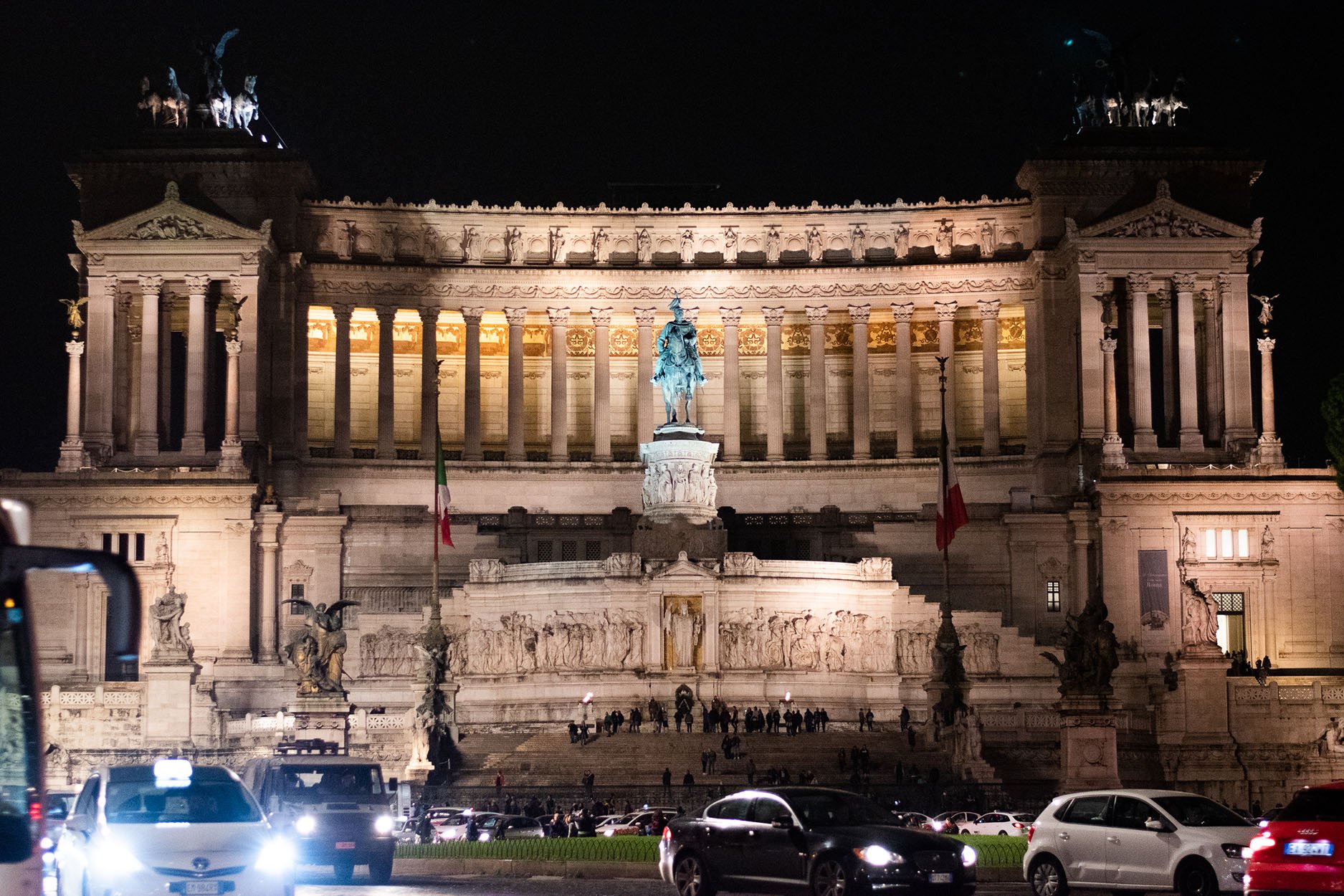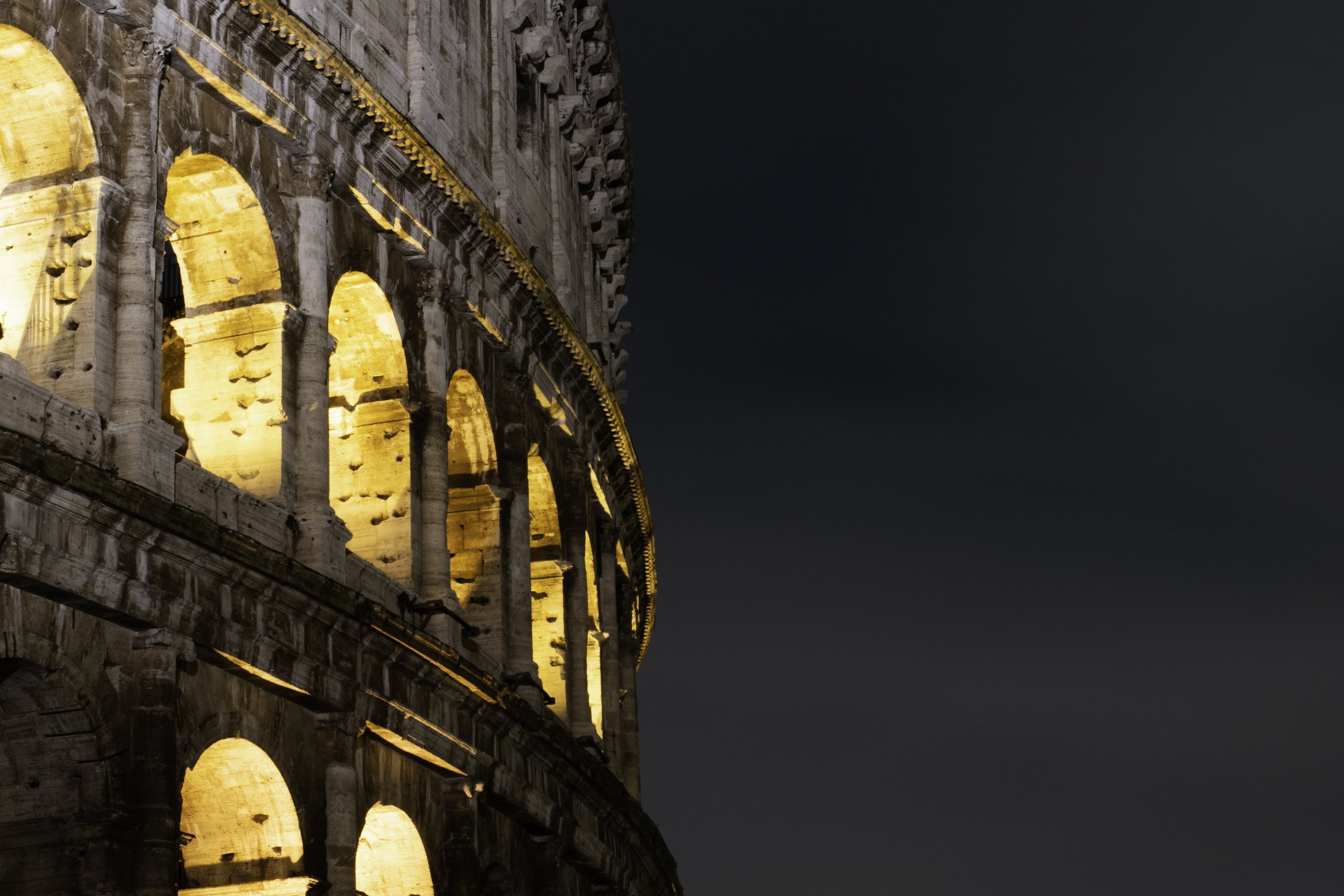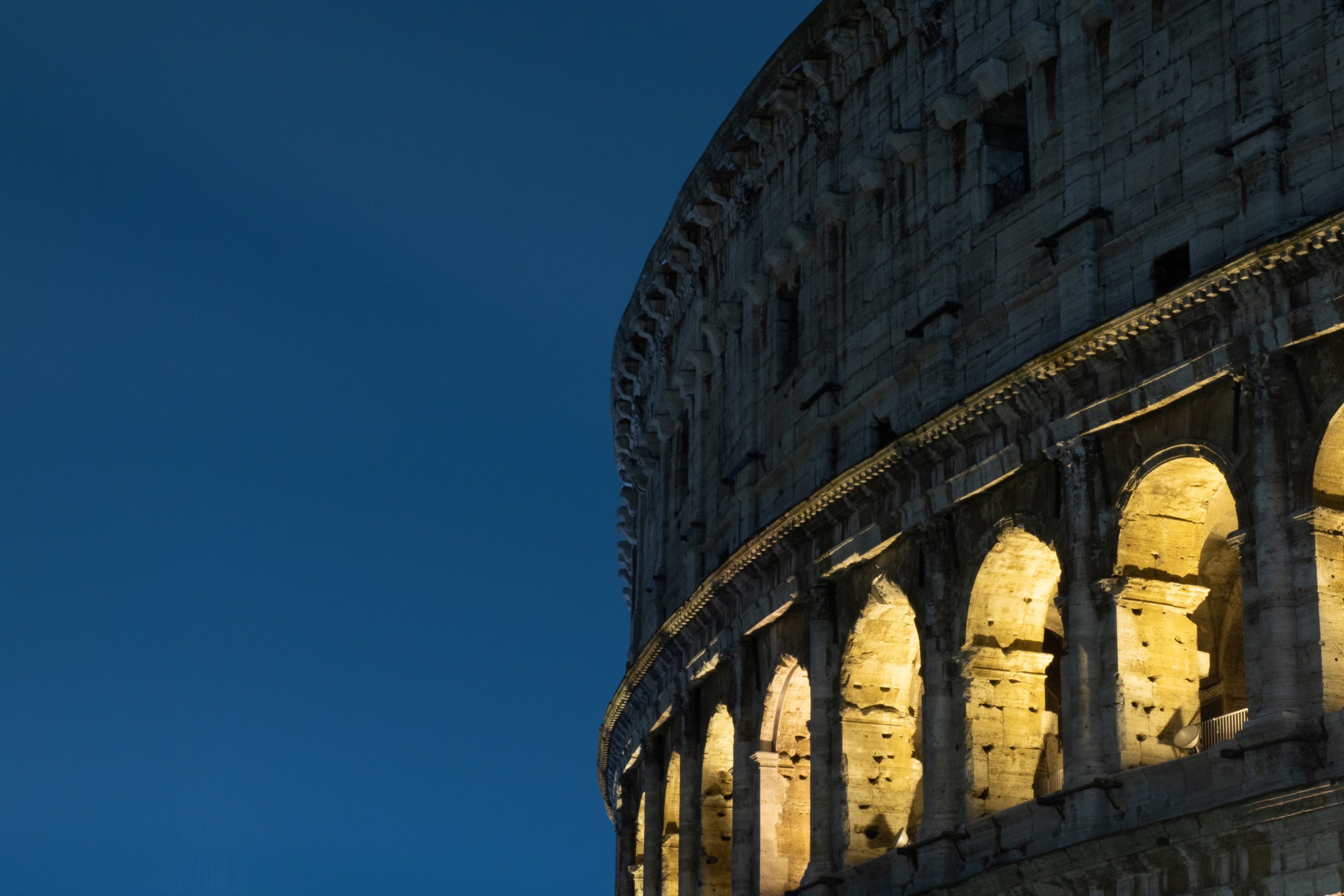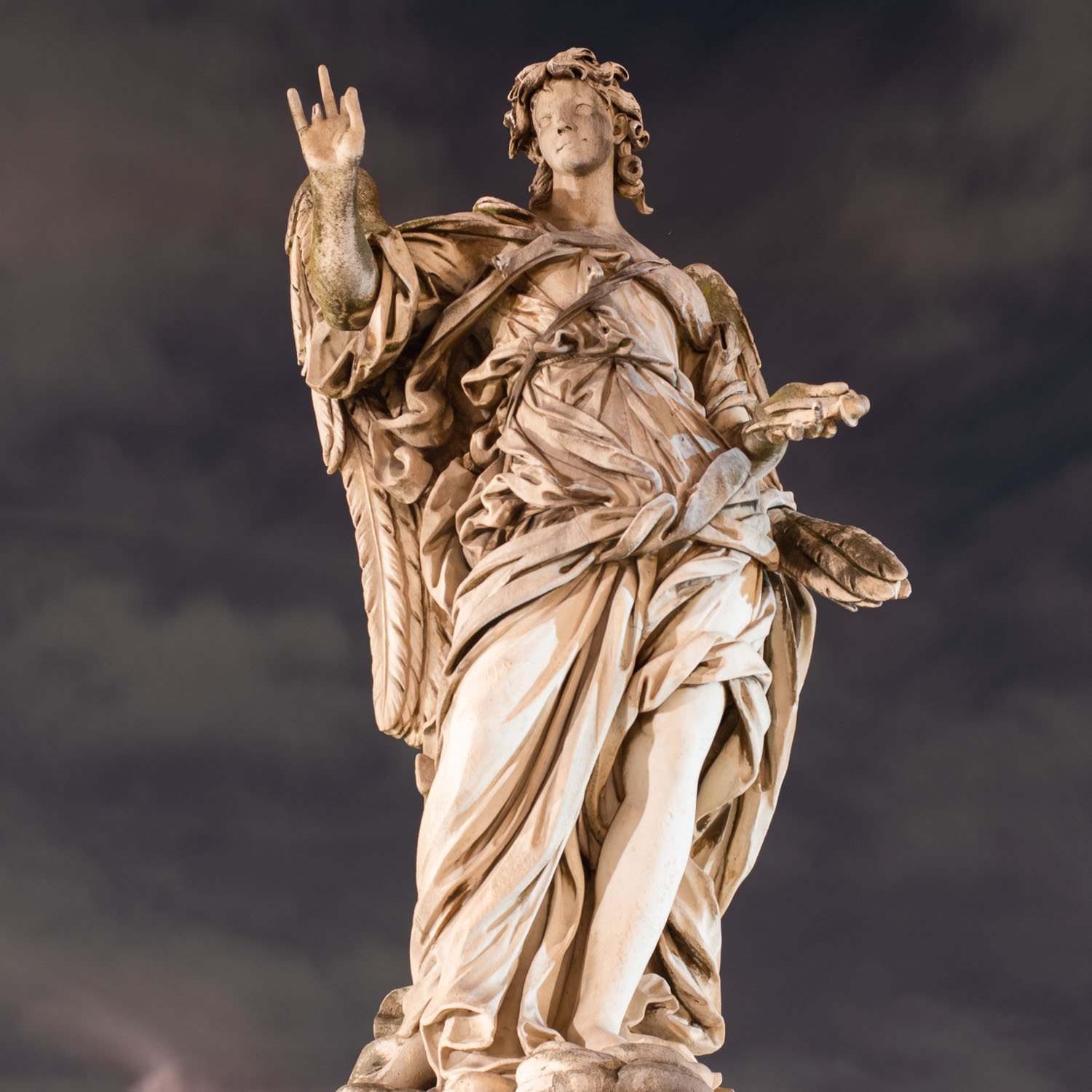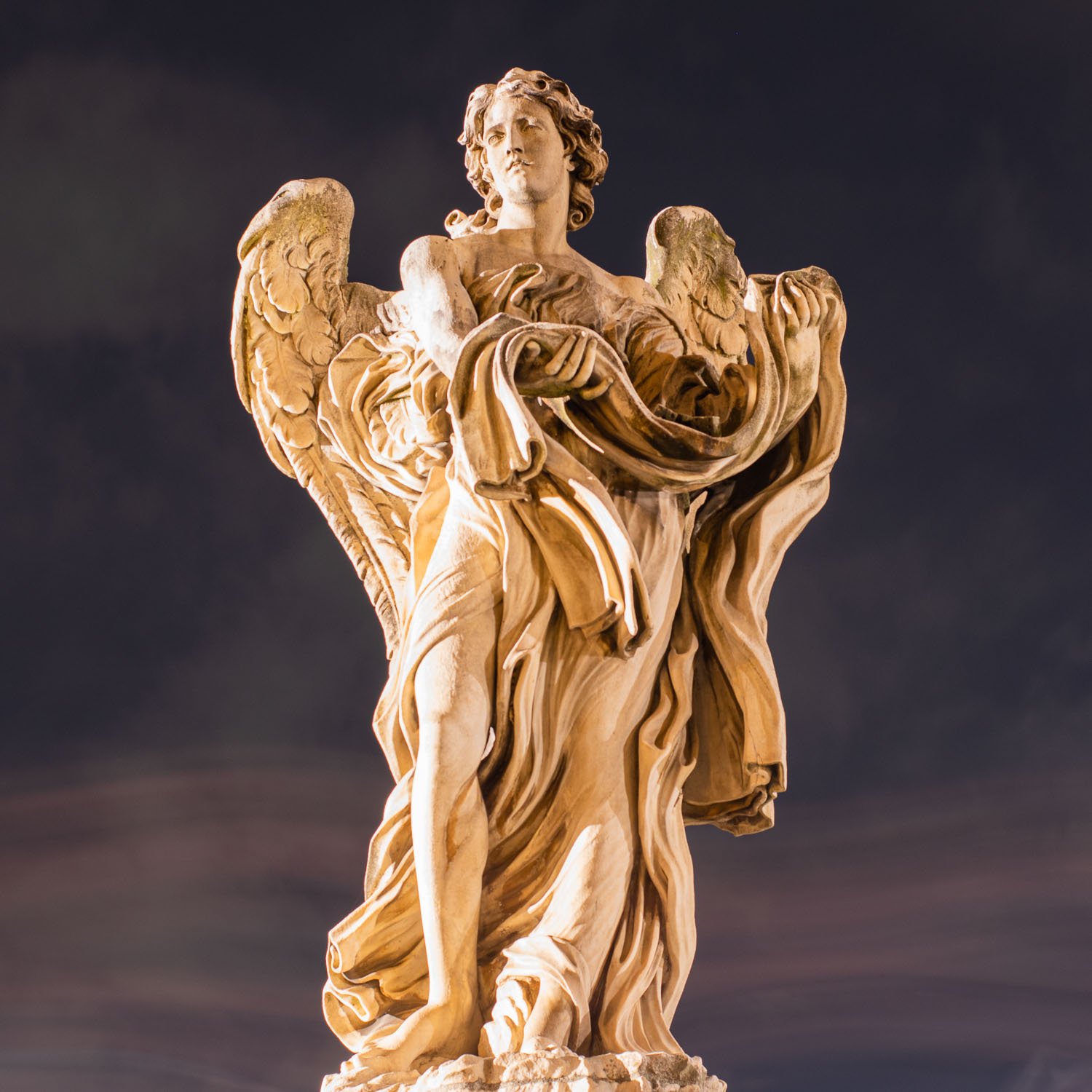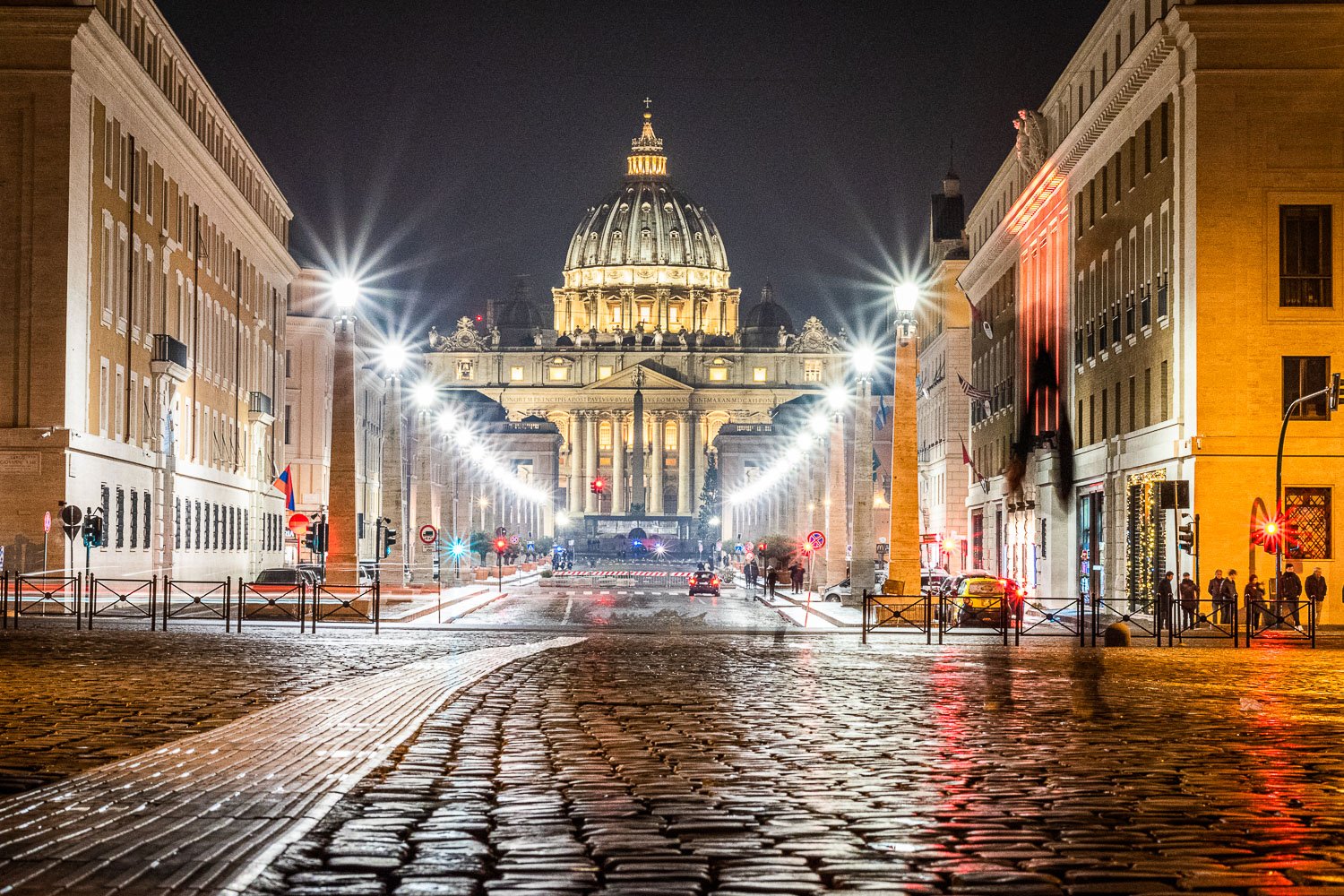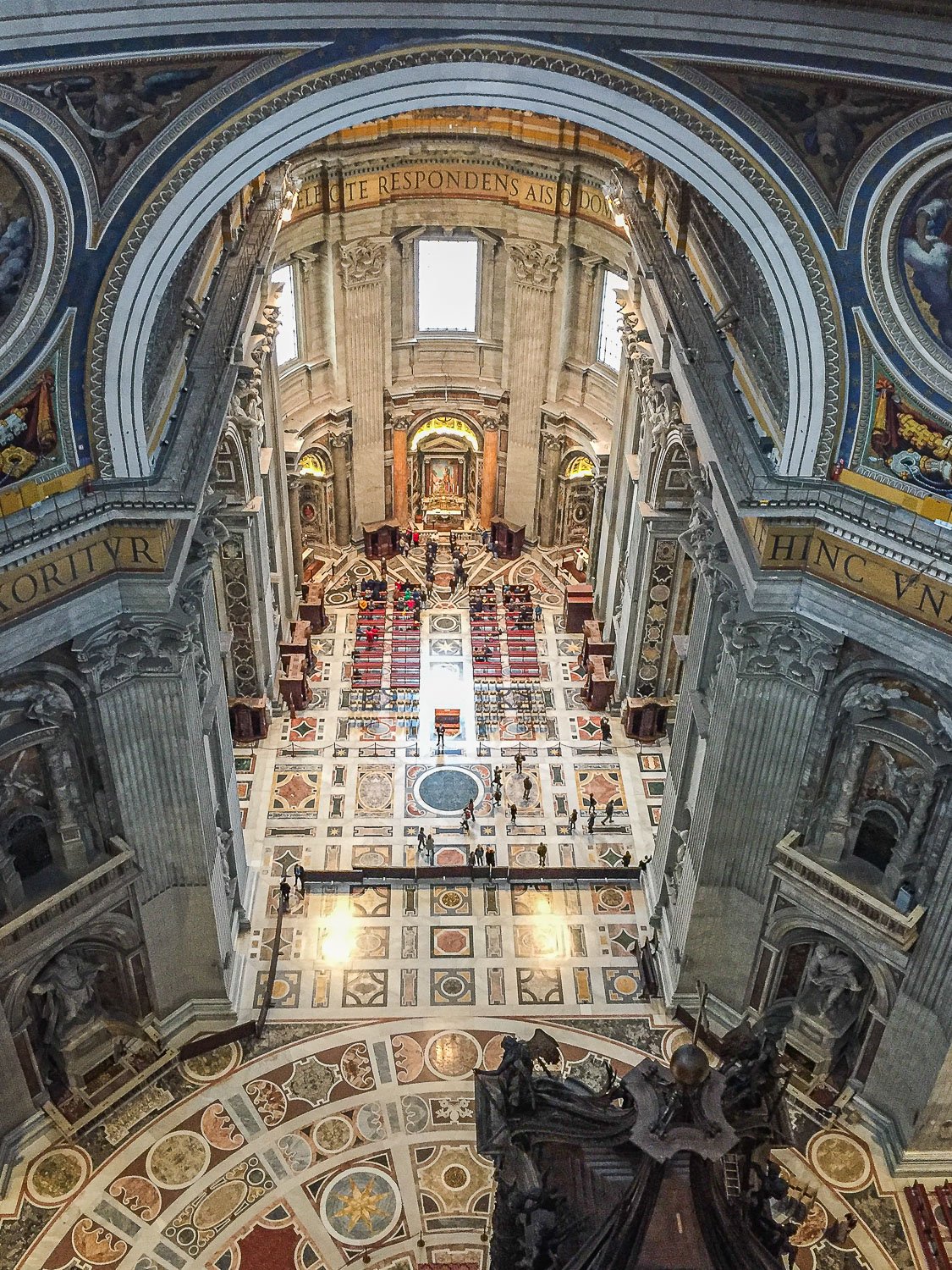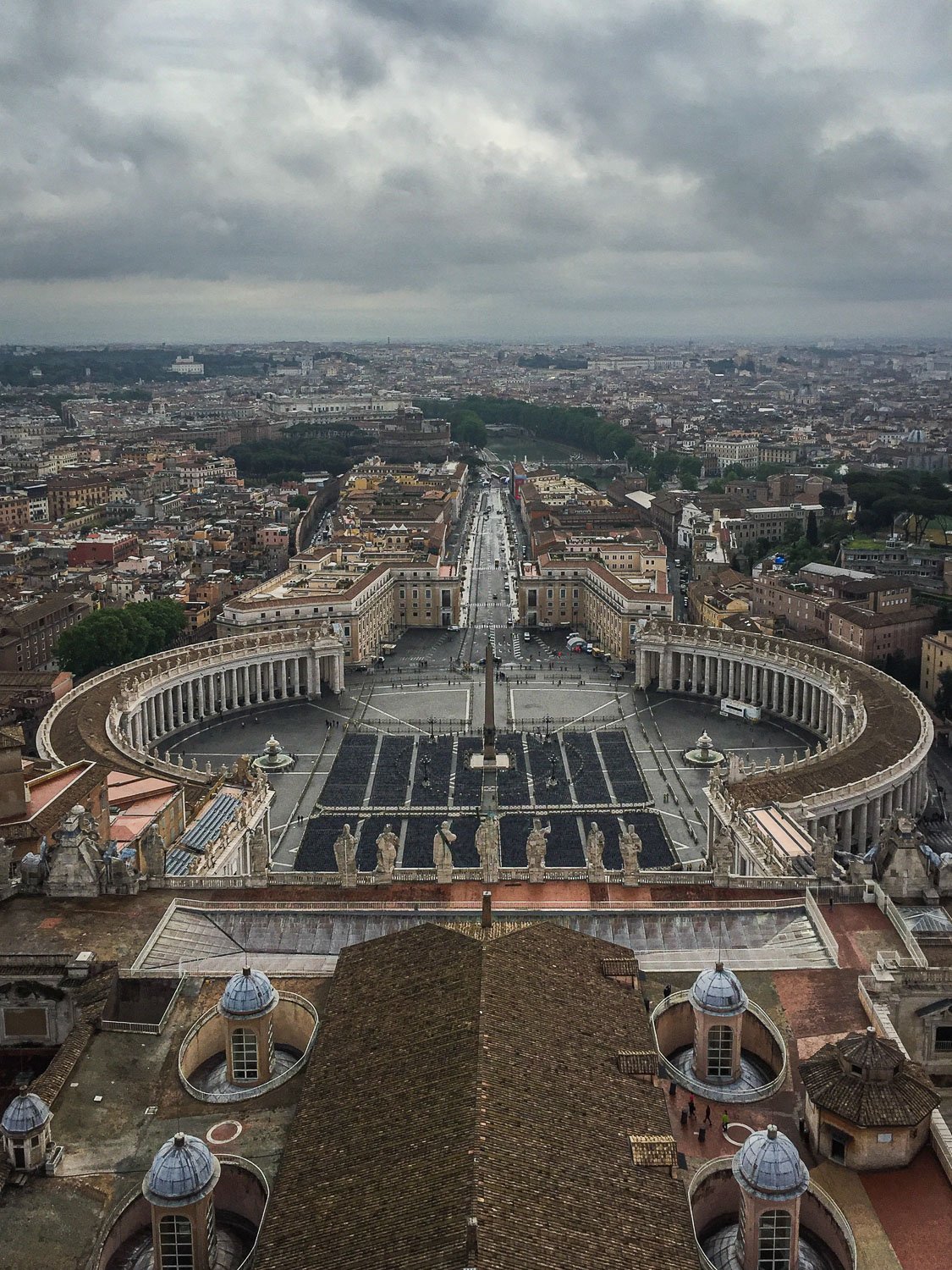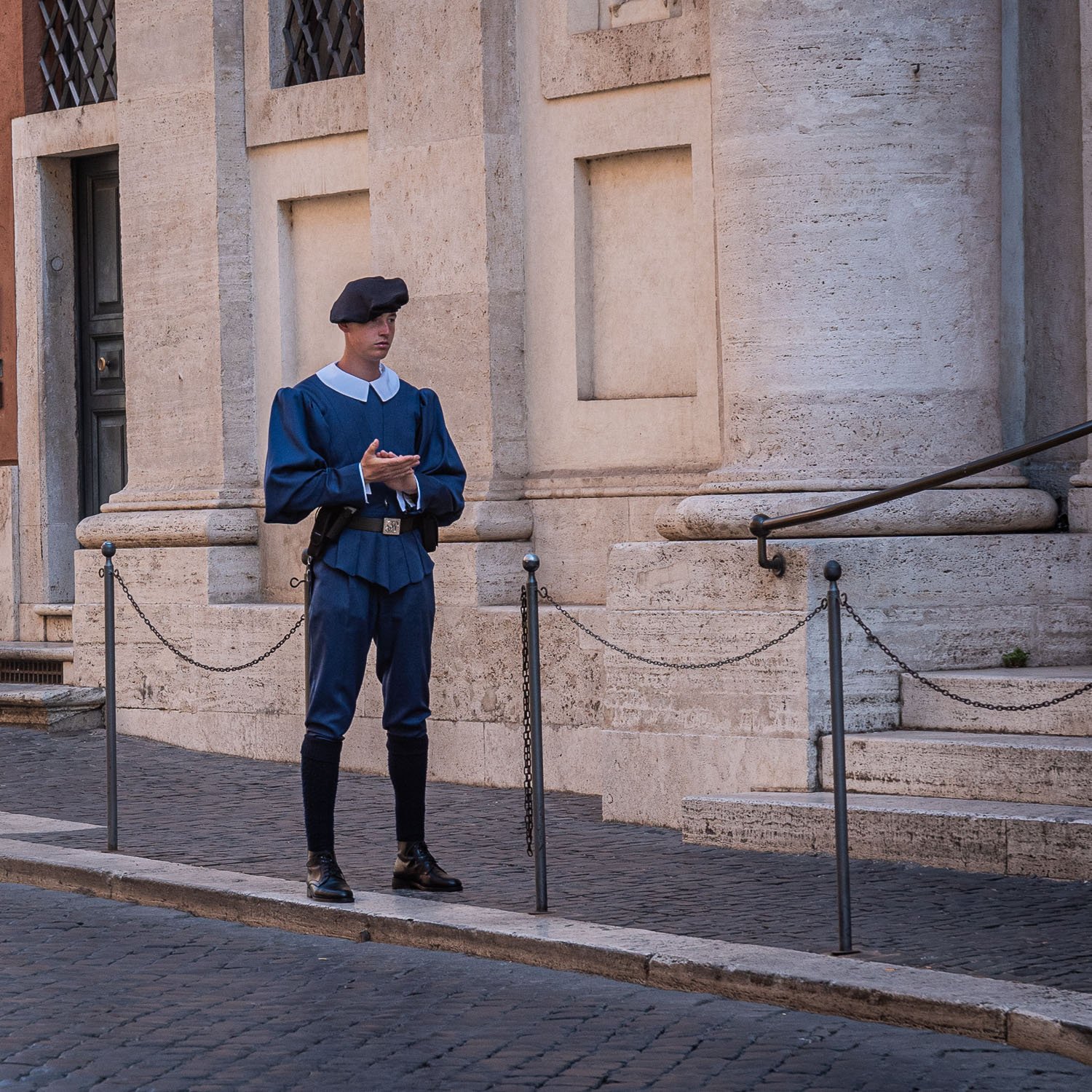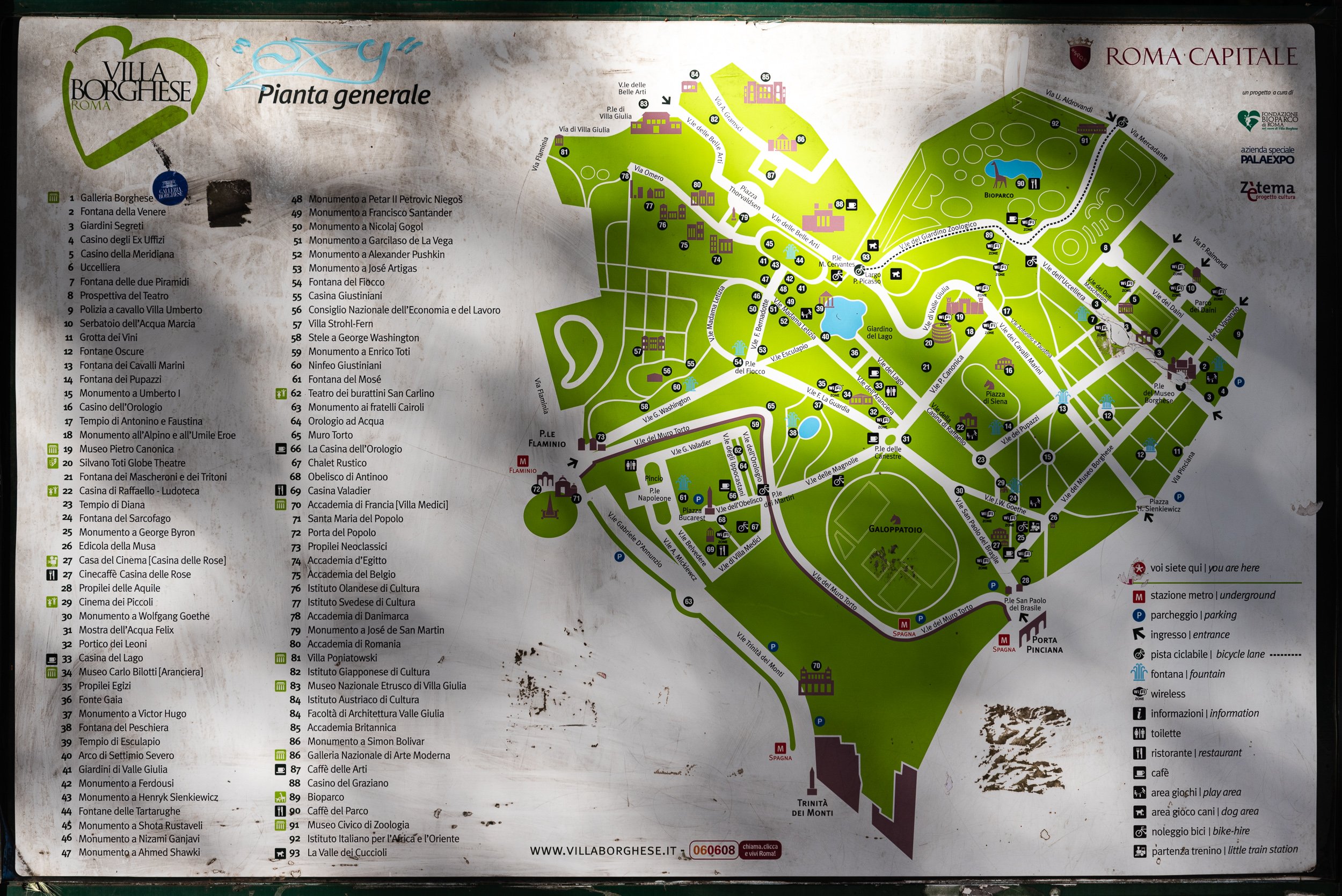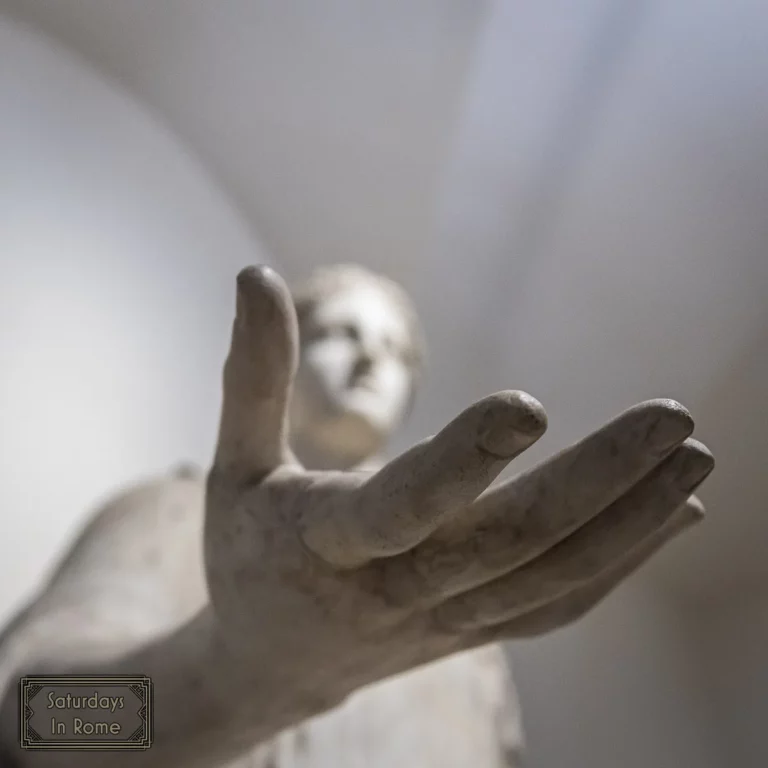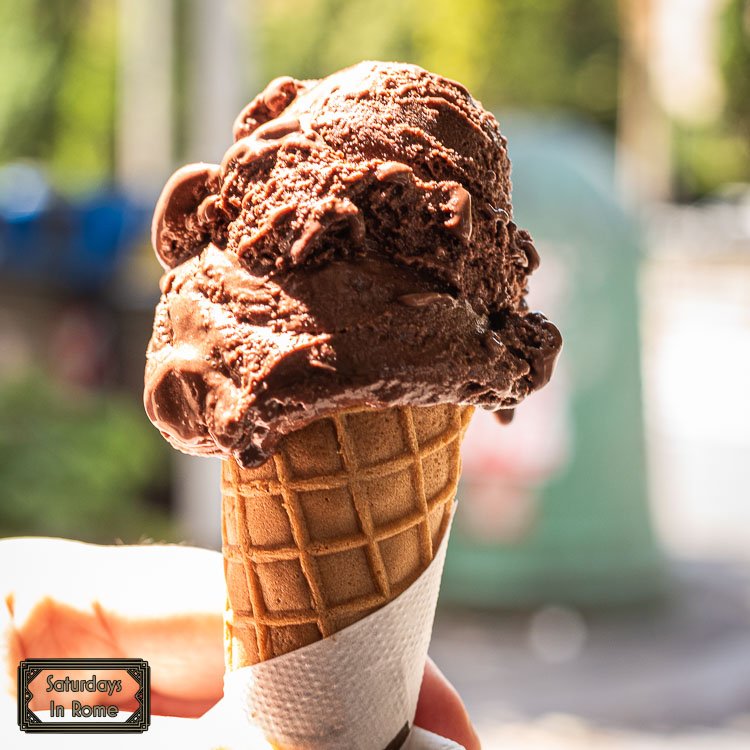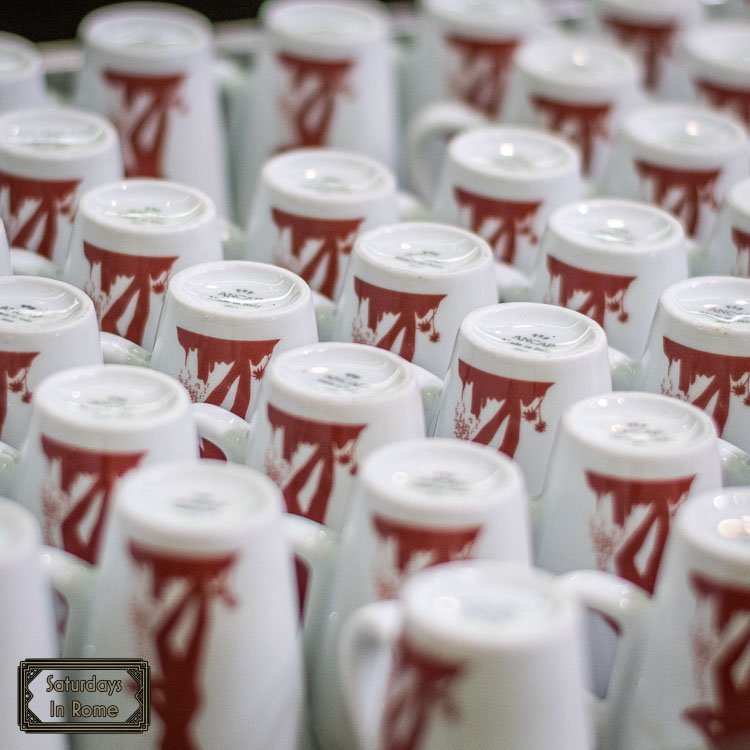A Rome Travel Itinerary For Amazing Vacation Memories
This Rome travel itinerary for your first visit to the Eternal City is important so that you have a great vacation full of memories to take with you back home.
Welcome To Rome
If you are planning your first trip to Rome, then these recommendations are for you. There are a lot of beautiful historical sites, neighborhoods, shops and restaurants around Rome and it is easy to get overwhelmed. You could work with a tour company, but if you are like us and you like to plan your own adventure, you might consider using this as a framework that you can update as you see fit.
Need Help Planning?
- Cheap Flights: Find The Most Affordable Flights.
- Accommodations: From 1 to 5 Stars And More.
- Car Rentals: Affordable Travel Across Italy.
- Sightseeing Tours: Explore Some Amazing Tours.
- Buying An eSIM: Stay Connected In Italy.
This post includes affiliate links.
This itinerary assumes you will only be in Rome for three days, it assumes you aren’t on a pilgrimage so your focus isn’t solely on religious sites and it assumes it isn’t too hot and you are able to walk around for the entire day. I know the summer months can be difficult for that, so if it is too hot, you should add in more water breaks.
My other assumption is that since I would have no way to know your starting point, i.e. which hotel, Airbnb, hostel, cruise ship, etc. you are staying in, I am assuming a starting point that is fairly central where you can enjoy the Piazza Venezia History.
Rome Travel Itinerary Pre-Day 1
- Make reservations for the Colosseum tour you are interested in. I recommend the Underground Tour
- Call to make Day 1 reservations for lunch at Trattoria Morgana, and Aperitivo at the Hotel Forum and dinner at Vecchia Roma
- Call to make Day 2 reservations at Pizzeria da Michele for lunch and Cacio e Pepe for dinner
- Call to make Day 3 reservations for lunch at Tony and Dino’s and dinner at Roscioli
Rome Travel Itinerary Day 1
- Start with a cornetto and an espresso after walking down to a bar near The Colosseum.
- Visit The Colosseum for your Underground Tour.
- After the tour, walk over to your lunch at Trattoria Morgana.
- To work off your lunch, walk along via Di San Gregorio to the Circus Maximus, continue on and visit Bocca della Verità
- Continue to Piazza Venezia, making a big circle and walk around the Forum.
- Walk over to the Pantheon, but on your way you should stop for a coffee at Tazza d’Oro
- Head out for an aperitivo at a rooftop bar like the Hotel Forum.
- Enjoy a long dinner at Vecchia Roma in either Esquilino or Monti.
- Return to your lodgings and rest up and prepare for two more full days of touring around the city.
Rome Travel Itinerary Day 2
- When you wake up early, excited to start the day, head towards Trevi Fountain and get there before the crowds. Stay and enjoy the peace while you review your plans for the day.
- When you have gotten your fill of the fountain, you can continue on to the Spanish Steps and start with a coffee and cornetto at Caffè Greco.
- While you walk down Via del Corso and Via del Babuino, take notice of the Talking Statues.
- Enjoy the Spanish Steps and walk down to the Borghese Gardens.
- Stop at Pizzeria da Michele for lunch.
- After lunch, return to Piazza del Popolo and stop for coffee at Rosati or Canova.
- Take a leisurely stroll to Cacio e Pepe for dinner. If you are early, stop into a local bar for an aperitivo.
Rome Travel Itinerary Day 3
- Wake up and get an espresso, a cornetto or a pastry at a local bar
- Take the #64 bus to Vatican City, visit the Basilica di San Pietro and climb the Cupola di San Pietro
- Stop for lunch at Tony and Dino’s
- Walk around Prati for some casual shopping
- Visit the outside of Castel Sant’Angelo, cross the Ponte Sant’Angelo and walk over to Piazza Navona, taking notice of another Talking Statue.
- Stop and have a coffee in Piazza Sant’ Eustachio at Il Caffè.
- Head towards Roscioli for dinner and top off the night with gelato at Fatamorgana.
That was a full three days. Now is the time to relax and reflect on all the great sites you saw, all the delicious food you ate and how great Italian coffee is. If you missed any of the recommendations, you should consider adding them to the front of your itinerary for your second trip to Rome.
Some of The Sites From The Rome Travel Itinerary:
The Colosseum
The Colosseum in Rome (il Colosseo) is an amazing structure with a long history that spans more than 2,000 years. The Colosseum, also known as the Flavian Amphitheater, was considered a gift to the Roman people by the Emperor and that is a gift that still keeps giving, but now to the world.
A Brief History Of The Colosseum
The Colosseum functioned the same as the stadiums of today, to provide entertainment to the masses in Rome. It did this by providing a stage for the exotic animals captured in all corners of the Roman Empire, to build the support for the emperors amongst the Roman people, to showcase the latest Roman engineering and to stage reenactments of famous Roman battles.
There are two surprising facts that I learned while touring the amphitheater (meaning “theater in the round”). First, all the Colosseum’s major events were free to the public. The emperors themselves would pay for them. This public gift was a way to gain favor of the people of Rome. This obvious bribe is still practiced today by politicians across the world. The second thing I learned from our tour guide is that contrary to popular belief Christians were never martyred in Il Colosseo. The guides try to make this abundantly clear, which isn’t to say a lot of people didn’t die there. They did! There were particularly brutal games in which 10,000 animals were killed in a single day.
How Was It Built?
Construction of the Colosseum began in 72 AD and was financed by treasures taken from the Jewish Temple and the workforce consisted of 12,00 Jewish prisoners (i.e. slaves) after the Great Jewish Revolt in 70 AD. The slaves worked long hours under harsh conditions, including bringing the travertine building blocks from a quarry 20 miles away in Tivoli. The construction took 8 years and once completed, a 100-day long inaugural games were held at the new Flavian Amphitheater in 80 AD which were paid for by the Emperor.
Where Is The Colosseum?
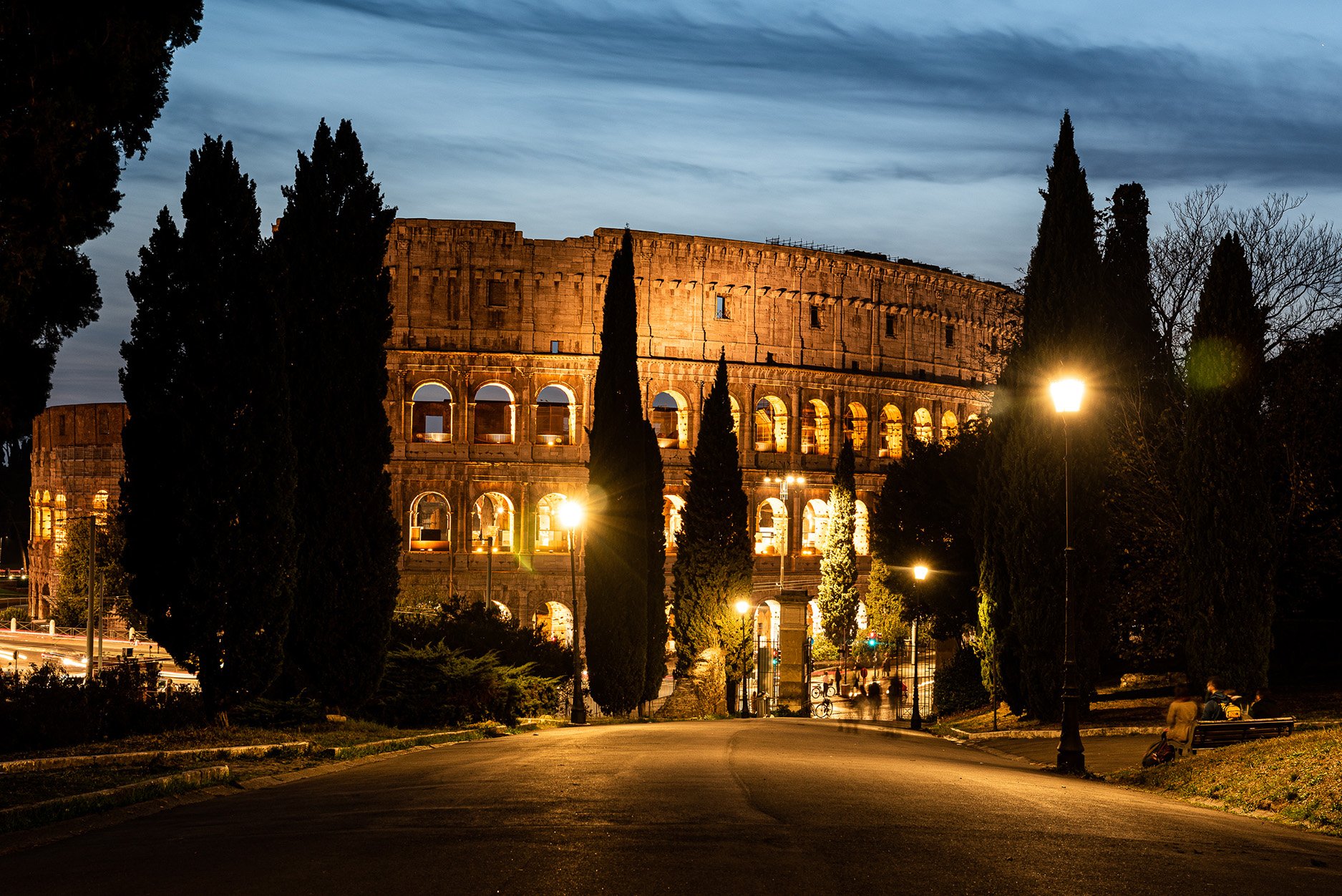
The Colosseum At Night
Let’s start with where it IS NOT and that is Las Vegas. Apparently Caesars decided to build a performance space in Nevada and called it The Colosseum. I have a lot of opinions about Vegas, but they aren’t really relevant for this blog, so I’ll leave it at this: The Colosseum is in Rome, and the gondoliers at The Venetian in Vegas are also fake. Oh, and one other thing, The REAL Colosseum does not have an Instagram account.
The Colosseum is certainly in Rome. In fact, it was built in the center of Rome and is just east of the Roman Forum. One of my favorite experiences continues to be walking from Piazza Venezia down Via dei Fori Imperiali towards the Colosseum at any time, early morning when it is empty, at night when it is lit up, and even during the day.
If you want to get to the Colosseum using public transportation, you have many options offered by ATAC:
- Take the subway, Metro B, and get off at the Colosseo stop.
- Take a city bus, lines 75, 81,673,175 or 204 will get you there.
- Tram #3 is an option, but they run less frequently.
How Big Is The Colosseum?
Another Angle of the Colosseum at Night
This massive elliptical structure is four stories high and approximately 620 x 513 feet. It has 80 entrances and exits, which is something to think about if you have ever been to a modern stadium and waited more than 30 minutes to exit because of the crowds. To compare the sizes to Football or more appropriately Baseball stadiums of today, the Colosseum could hold around 50K spectators and that is approximately the same size as Yankee Stadium, which can hold up to 54K fans. It is an impressive size, but Football still wins, with Cowboys Stadium holding up to 80k spectators.
What Is Inside The Colosseum?
Below the Colosseum floor there are the remains of numerous rooms and underground passages. There were trap doors and elevators used to launch the animals and gladiators onto the main floor. Pulley systems were also used to raise and lower scenery used for elaborate battle reenactments. There is even an elaborate drainage system that was used to flood the arena and reenact naval battles with specially trained swimming horses and bulls.
The stands were divided into sections according to social standing. The emperor carefully managed the separation of the different classes at all public spectacles. The Ima Cavea section was reserved for the emperor, politicians and vestal virgins, with their names having been written on their seats. The higher you go in the stadium, the poorer you were, with the top level available to the lowest class and the slaves.
The Restoration Of The Colosseum
Because of the Colosseum’s 2,000 years of age and the effects of pollution, it has gone through regular and ongoing restorations. There was a major restoration program carried out in the 90’s costing almost $20m. Recent updates include a restoration of the external façade, which was completed in 2016, and in 2018 a new initiative was started with a focus on the underground passages, cages and rooms where prisoners, animals and gladiators were kept.
Were There Gladiators In The Colosseum?
Of course there were gladiators in the Colosseum, didn’t you see the movie? Also, there is a hostaria right across the street named Hostaria al Gladiatore and that couldn’t be right outside if it wasn’t true.
Seriously though, the gladiator contests were a major part of the entertainment in the Colosseum with a gladiator training site right outside. The gladiators’ barracks at the Ludus Magnus just across Piazza del Colosseo were connected to the arena by tunnels. The Ludus Magnus had its own miniature training arena, which was also a popular attraction for Romans.
How Do You Get Tickets?
The Colosseum During Late Blue Hour
You can wait in a very long line at the Colosseum, but I wouldn’t recommend it. There are an almost infinite number of tour groups that might be your speed, or you can go to the website of Il Ministero della Cultura and decide what ticket is right for you. I would recommend checking out this post about buying tickets for the Colosseum.
I also wrote a post about: “Is The Roma Pass Worth It?”, which I would recommend taking a look at before you make any decisions.
What Are The Hours?
Keep in mind that the last entry is one hour before closing time. The hours are:
9:00 am – 7:15 pm from March 27 to August 31
9:00 am – 7:00 pm for the month of September
9:00 am – 6:30 pm from October 1 to October 31
9:00 am – 4:30 pm from October 31 31 December 21
By the way, I was not totally correct above, the park does have an Instagram account!
The Pantheon
One of the most beautiful and well preserved ancient sites in Rome is the Pantheon. Built in the Piazza della Rotonda, this is the Pantheon’s third version and it is the only ancient building in Rome in continuous use since its construction. The first version was built during the reign of Emperor Augustus and commissioned by the famous Roman general Marcus Agrippa. Agrippa and the Emperor were friends and he eventually became the son-in-law of the Emperor after marrying his daughter.
The name Pantheon is a dedication to All Gods which speaks to the polytheism of the Roman Empire, but also refers to the statues of the 12 major Roman deities that were placed around the building.
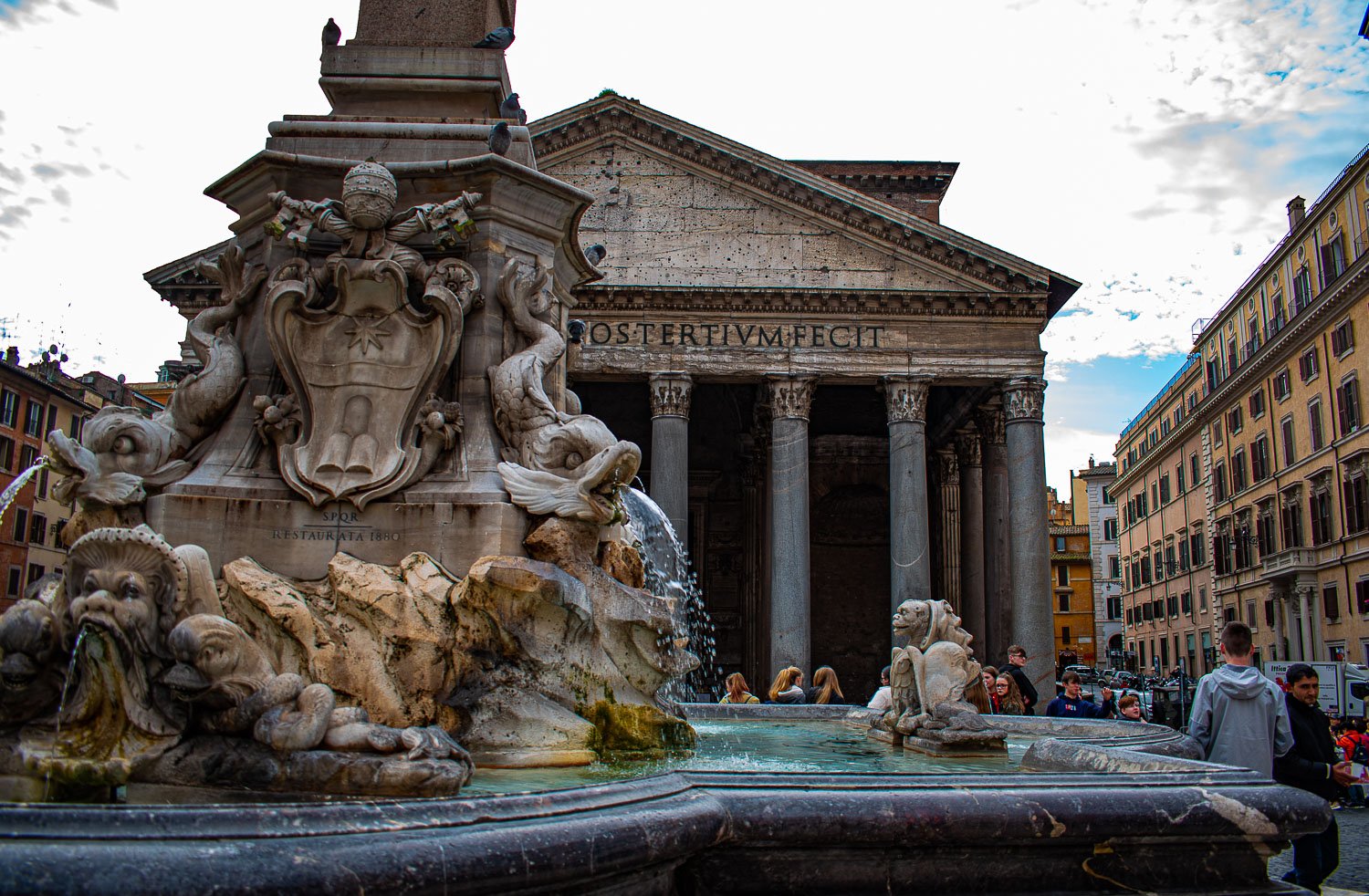
The Pantheon
The first version of the Pantheon, which was started in 27 BC and completed in 17 BC, burned to ground. The exact form of the Pantheon is debated because of the destruction of everything except for the façade. It was rebuilt under Emperor Domitian in 80 AD, but it burned down a second time in 110 AD. The third version of this temple was built in 127 AD under the reign of Hadrian. The structure of the building was wood, which is why it was able to burn down repeatedly.
Outside The Temple
The Pantheon, with its circular foundation, was made to look like a Greek temple with a portico of 16 enormous Corinthian columns and cross-beams under a pediment. The columns are 40 feet tall, 15 feet around and each is made of a single piece of granite. The walls are a shell of bricks filled with poured concrete.
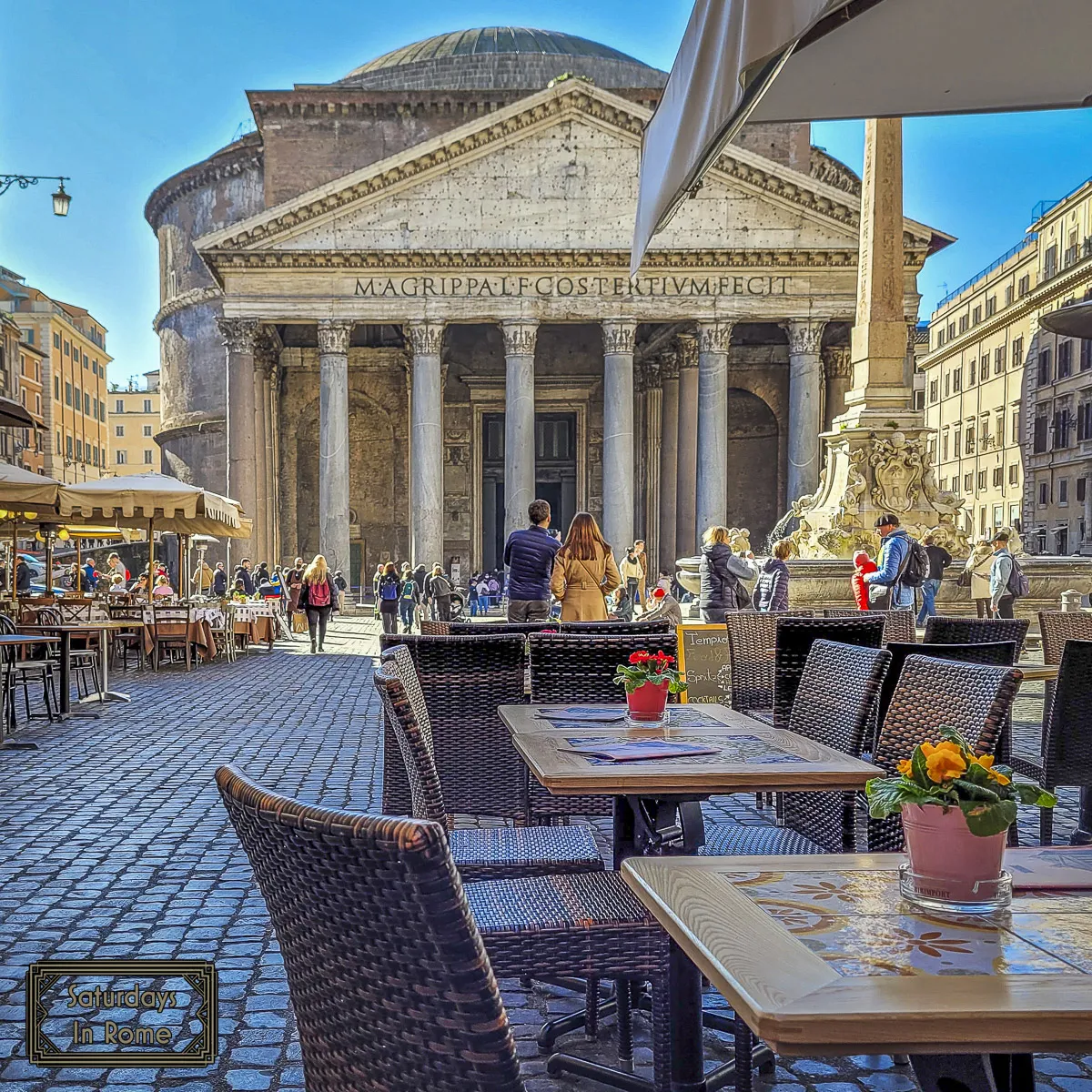
Emperor Hadrian gave credit to the original builder by including the inscription from the original temple, which reads:
M.AGRIPPA.L.F.COS.TERTIUM.FECIT
which translates to: Marcus Agrippa Son Of Lucious Third Time Consul Made This.
Sadly, most of the ancient decorations have been lost over the years due to looting. For example, after the temple was consecrated as a Catholic church, which saved it from being abandoned, it was described by Paul the Deacon paraphrased as:
“Remaining at Rome twelve days, Emperor Constans II pulled down everything that in ancient times had been made of metal for the ornament of the city, to such an extent that he even stripped off the roof of the church, which at one time was called the Pantheon, and had been founded in honor of all the gods and was now by the consent of the former rulers the place of all the martyrs; and he took away from there the bronze tiles and sent them with all the other ornaments to Constantinople.”
The Pantheon Fountain (la Fontana del Pantheon) is located outside the Pantheon in the Piazza della Rotonda and was commissioned by Pope Gregory XIII. It is topped with an Egyptian Macuteo obelisk that was created during the period of Ramses II and it was in a temple in ancient Rome dedicated to Egyptian Goddess Isis.
Inside The Temple
The dome inside the Pantheon makes it unique, and possibly the most influential dome in history. It is the model and inspiration for Cathedral (Cattedrale) dome in Florence, for Michelangelo’s dome in the Basilica of St. Peter and for the US Capital.
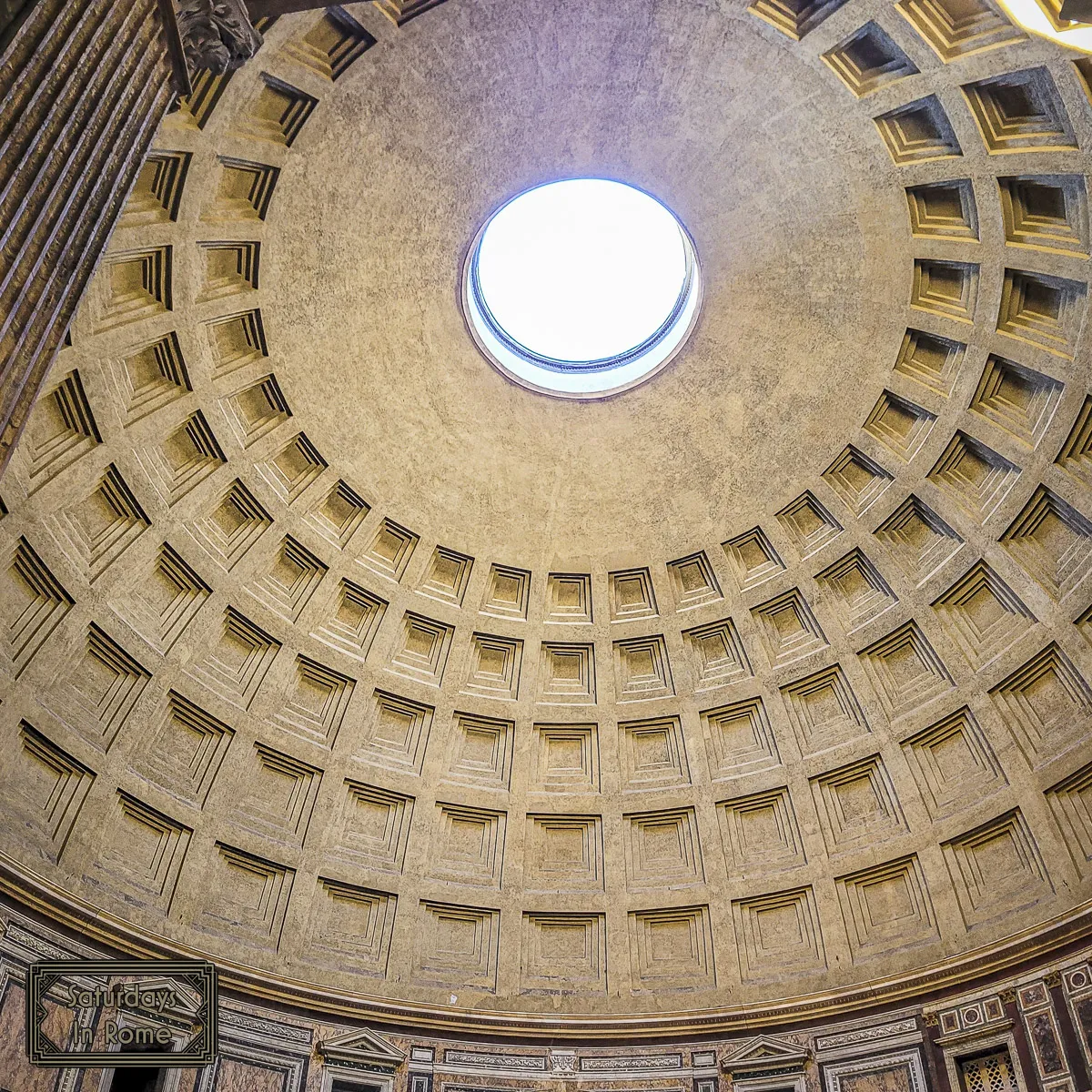
The most striking feature inside the Pantheon dome is the Oculus. Symbolizing a pathway to the heavens, this circular hole is at the center of the dome and the only source of natural light in the interior. It is open to the weather, which helps to keep it cool and well ventilated. There is drainage built into the floor with a 12 inch incline for rain to drain out.
The dome is as high off the ground as it is wide, 142 feet, with a perfectly semi-spherical shape. It is made of concrete, invented by Rome, heavier at the bottom and almost 20 feet thick, they get thinner as you ascend to around 5 feet thick.
The Tombs
There are niches around the temple that contain the tombs of some of the most important figures in Roman and Italian history. Among these are:
Raphael (1483-1529) – He is one of several artists buried in the Pantheon and being so much more popular than the others, they carved out the marble in front of his tomb and replaced it with glass so you can see his tomb. The inscription on the tomb, written by Pietro Bembo, reads in latin: “Here lies Raphael whom while he lived nature feared to be out done but now that he lay dying she fears that she will die herself”. Raphael died at 37 years old on his birthday after what is described as a wild night with his mistress, known as The Baker’s Daughter (La Fornarina).
King Victor Emmanuel II – The first king of Italy is on the opposite side from Raphael. He is known as the Father of Italy, with the inscription: Padre della Patria. His son, Umberto I is also buried there, although not as popular as his father. Another nearby tomb is that of the queen and first cousin of Umberto I, Margarita, who is also of pizza fame. Fresh flowers are placed at these tombs by Royalists, Social Conservatives and Fascists to celebrate the monarchy. I previously answered the question: “Does Italy Have A King?”, so please check that out.
Visiting Hours
Admission is free from Monday to Friday and opening hours for the Pantheon are as follows:
The Basilica is open everyday from 9.00 am to 7.00 pm
Is it closed on:
January 1st (New Years Day)
August 15th (Ferragosto)
December 25th (Christmas)
Last Admission Is 30 minutes before the closing time
Times may vary due to special religious celebrations so please check their official website or their Facebook page for more details. Generally, since the Pantheon has been in continuous use since 609 AD masses are held regularly at 5.00 pm on Saturdays and on pre-holidays, and at 10.30 am on Sunday and public holidays.
If you are looking to visit the Pantheon on weekends and public holidays it will be necessary to book the visit at least one day in advance. For those who book a tour with an audio guide or a tour with an audio guide and printed guide or a guided tour on this website, you will need to show the voucher at the entrance at your chosen visiting time.
Ponte Sant’Angelo
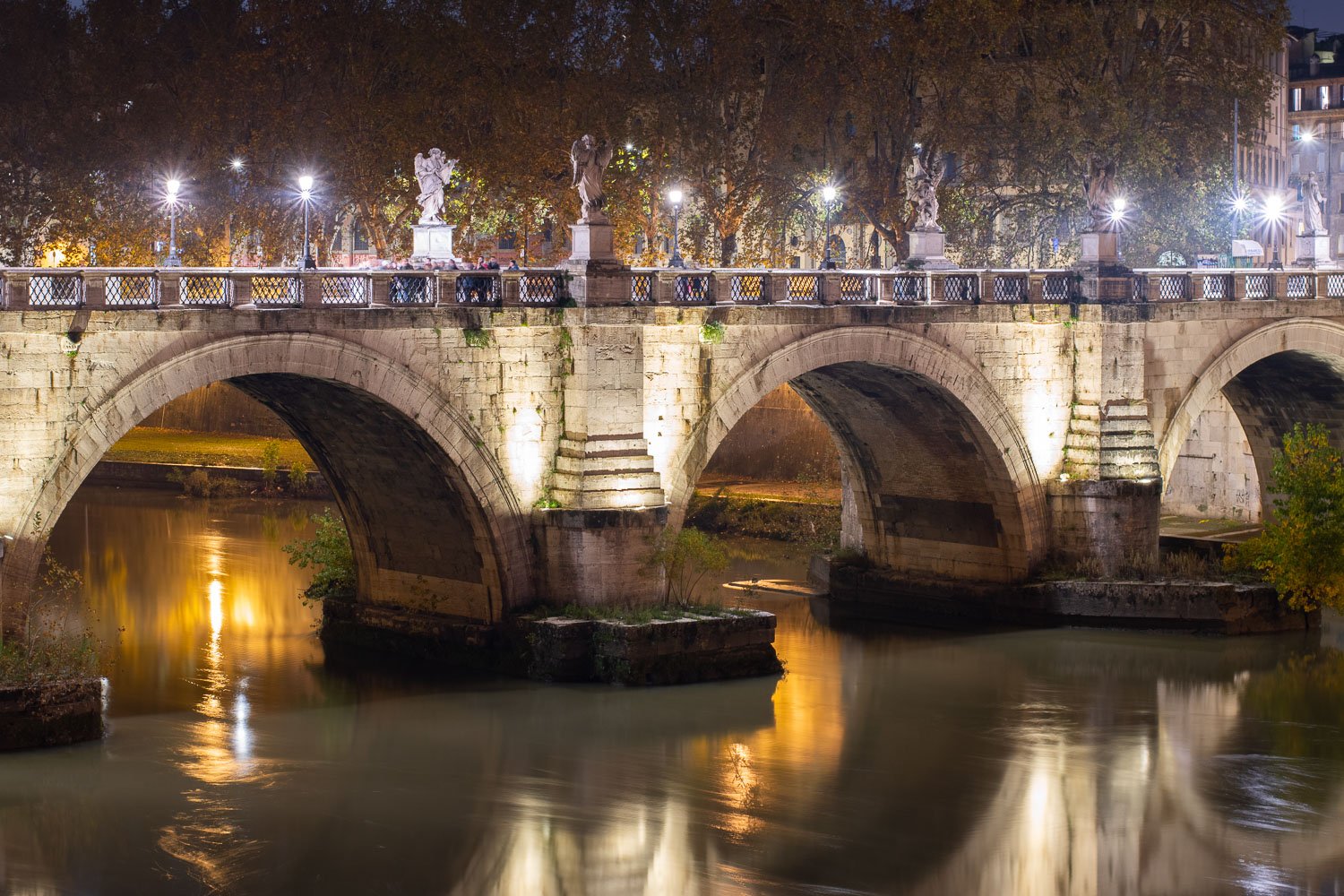
Ponte Sant’Angelo at Night
The Ponte Sant’Angelo is a pedestrian bridge that was originally named after the emperor Aelius Hadrian who built it between 130 and 136 A.D., although there are varying views on when it was exactly finished, to connect the city with the entrance to his mausoleum in the Castle Sant’Angelo on one side of the bridge. The sturdy build of this bridge is demonstrated in the fact that no flood of the Tiber has ever managed to overwhelm or damage it.
During the Middle Ages the name was changed to Saint Peter’s Bridge (Ponte San Pietro) as it provided, at that time, the only direct access to the Vatican and Saint Peter’s Basilica from the city, following the ruin of Nero’s Bridge. Over the centuries it was enlarged and rebuilt to meet new traffic requirements.
The importance of Ponte Sant’Angelo is because for centuries it was the main bridge to St. Peter’s Basilica, and the Vittorio Emanuele II Bridge, located downstream and closer to Saint Peter’s Basilica, was actually built at the end of the nineteenth century.
The bridge, currently called Sant’Angelo because of the statue of the Archangel on top of the castle, has suffered several may changes over the years, including having its towers demolished and two statues depicting Saint Peter and Saint Paul being added. Ten more statues of angels carrying the symbols of the Passion were added in 1668.
Angel With The Nails
The history of this bridge is not all about beauty. For many years the square in front became one of the places where the death penalty was carried out and it was customary to expose the bodies of those executed on the bridge, as a warning to the population. The first show of punishment dates back to the year of 1500, but in the following years the hangings were so common that the people had a lot of fun saying:
“There are more severed heads on the shoulders than melons at the market”.
The Statues
One of the peculiarities of Ponte Sant’Angelo is certainly the collection of the many statues that line the two sides of the bridge. Initially, only the statues representing Saints Peter and Paul were on the bridge, but later they gradually added pairs of angels, up to a total of 12 statues, designed by Gian Lorenzo Bernini, but created with and by his students with the common theme of the Passion of Christ, and in particular, Via Crucis.
Although not part of the originals, the statues of Saints Peter and Paul became famous Rome statues known as The Talking Statues and conversed on several occasions with Pasquino. For me, it’s a little hard to rationalize the idea that this bridge, having been a location for hangings, would be in any way aligned with the Talking Statues, which were used as a method of political discourse.
Here are the names of the statues, some of which I have added pictures to this post:
Angel with the Garment and Dice
- Angel with the Column – This angel carries a column that represents the pillar to which Christ was chained while being whipped.
- Angel with the Whips – This angel is holding the whip used by the Romans to torment Jesus while he was bound to the column.
- Angel with the Crown of Thorns – The well known crown of thorns was placed on Christ’s head to mock him.
- Angel with the Sudarium (Veronica’s Veil) – Displaying Veronica’s Veil, which was left with the impression of Jesus’ face after it was used to wipe the sweat and blood from his face.
- Angel with the Garment and Dice – I think this is my favorite because of the addition of the dice. The statue represents the moment when Roman soldiers cast dice to determine who would receive Christ’s robe.
- Angel with the Nails – The nails used to stake Christ to the cross are featured in this sculpture.
- Angel with the Cross – The cross represents the cross that Christ was forced to carry through Jerusalem before being crucified.
- Angel with the Superscription – This angel is a replica of Bernini’s work. It portrays the sign nailed to the cross over Jesus’ head.
- Angel with the Sponge – According to the gospels of Matthew and Mark, one of the soldiers who crucified Jesus placed a sponge smeared in vinegar on a stick and pressed it to Jesus’ lips right before he died.
- Angel with the Lance – The lance represents the weapon that Roman soldiers used to pierce Jesus’ side, piercing his chest and confirming his death before lowering him off the cross.
Vatican City
Vatican City is an independent country within the borders of the city of Rome and is its own sovereign territory with its own authority, jurisdiction and diplomatic independence. The Vatican City State is an ecclesiastical monarchy ruled by the Pope, who is the bishop of Rome and head of the Catholic Church.
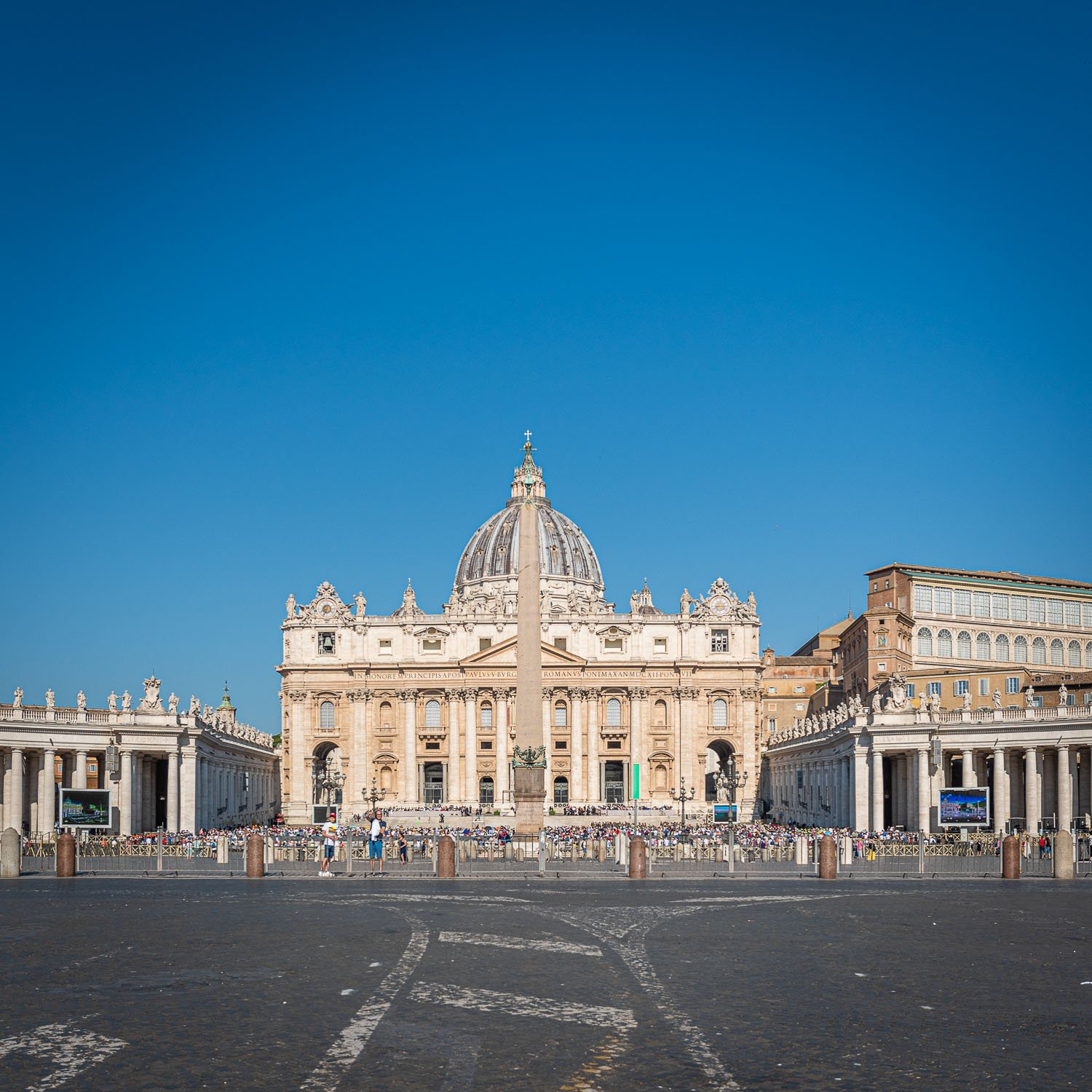
The Basilica With Small Crowds
Prior to the unification of Italy, the Pope ruled the Papal States, which had at times covered a large portion of the Italian peninsula. From the time that the country was unified in 1861 until the signing of The Lateran Treaty between the Holy See and the Kingdom of Italy, the situation was unclear and the influence the Vatican had over some or all of Italy was referred to as the “Roman Question”
This ambiguity became clearer on February 11, 1929 when the Lateran Treaty between the Holy See and the Kingdom of Italy was signed by Mussolini on behalf of King Victor Emmanuel III and by Cardinal Secretary of State Pietro Gasparri for Pope Pius XI. The treaty created the independent state of Vatican City.
Basilica At Night
Here are some Frequently Asked Questions about Vatican City:
- Is it a city or a country? Despite having the word City in its name, it is in fact an independent, sovereign state.
- Is it the smallest country in the world? Yes, it is the smallest country in the world in both population and area.
- Who lives there and can I live in Vatican City? It has a population of about 800, which consists of the clergy who run the city, and the Swiss Guards who defend the city. Unless you are one of those two groups, you will not be allowed to live in the city walls.
- What is the currency of Vatican City? Italy and Vatican City signed a contract allowing the Vatican to use the euro as its official currency despite not being a member of the EU.
- What is the official Language of Vatican City? Italian is the official language of Vatican City and their official newspaper is published in Italian, English, French, German, Polish, Portuguese and Spanish.
The Vatican Museums
The Vatican Museums (Musei Vaticani) are the public museums of the Vatican City. They display works from the huge collection amassed by the Catholic Church and the Papacy throughout the centuries. I wrote previously about the Vatican Museums and Sistine Chapel, so please do take a look at that post and let me know what you think.
The Vatican Necropolis
The Vatican Necropolis is an ancient Roman burial ground dating back to the third century that lies up to 35 feet below Saint Peter’s Basilica and is said to contain the grave and remains of Saint Peter, who was martyred in 64AD. The word Necropolis is Greek and means City of the Dead.
If you want to visit the Necropolis, understand that tour groups must be accompanied by a qualified guide. The groups are limited to sizes of 12 and there is a limit of 250 visitors per day. The current cost of admission is €13 and you can visit the site from Monday to Friday: 9:00 am to 6:00 pm, and on Saturday from 9:00 am – 2:00 pm.
St. Peter’s Basilica
Saint Peter’s Basilica is the most important one in the Catholic world. It unites the religious faithful and lovers of art and is a major pilgrimage site for the Catholic faithful. It frequently draws crowds of tens of thousands, both in the basilica and its adjoining St. Peter’s Square, which are used for a number of masses and celebrations during the year that are presided over by the pope.
Climbing The Cupola
St. Peter’s Basilica is free to enter and open everyday, from April to September from 7:00 am to 7:00 pm, and from October to March from 7:00 am to 6:30 pm. The Dress Code is strictly enforced at St. Peter’s Basilica. No shorts, bare shoulders or miniskirts. This applies to both men and women. I’ve entered with shorts on, but I’ve heard it is possible to be sent away, even if you got through security. The other important item during the summer is a hat, but from personal experience these are not allowed for men.
Climbing the Cupola, as seen in La Dolce Vita, is something that shouldn’t be missed if you can handle cramped spaces and a lot of stairs, because the views are amazing. The hours from April to September are 8:00 am – 6:00 pm. From October to March, 8:00 am – 4:45 pm. The cost is €10 if you want to use the elevator and only €8 if you can brave the stairs.
View From Cupola
Tours
There is what seems like an unlimited number of tour operators selling tours online for the Vatican and St. Peter’s Basilica, which is a testament to the popularity and importance of the Basilica. It is free to enter the Basilica, but the lines are unimaginable, so you need to get there early, or better yet, off-season.
I recommend that you purchase audio tours of the Basilica or simply download the Rick Steves app, which contains tours of the Sistine Chapel, St. Peter’s Basilica and the Vatican Museums. These tours will help get a handle on all of the beautiful artwork and architecture throughout the Basilica.
Swiss Guard Protecting and Serving
Swiss Guard
I want to finish this post with The Pontifical Swiss Guard, which is the small armed force and honor guard that is maintained by the Vatican for the protection of the Pope and the area within Vatican City. To become a Swiss Guard, you must be an unmarried, Swiss and Catholic male between 18 and 30 years old and you need to have completed basic training with the Swiss Armed Forces.
They were established in 1506 under Pope Julius II and the dress uniform is of blue, red, orange and yellow with a distinctly Renaissance appearance. I had heard that the uniforms were designed by Michelangelo, but this isn’t true. The design was introduced by commandant Jules Repond in 1914. His design was influenced by 16th-century depictions of the Swiss Guard in a fresco by Jacopo Coppi.
Borghese Gardens
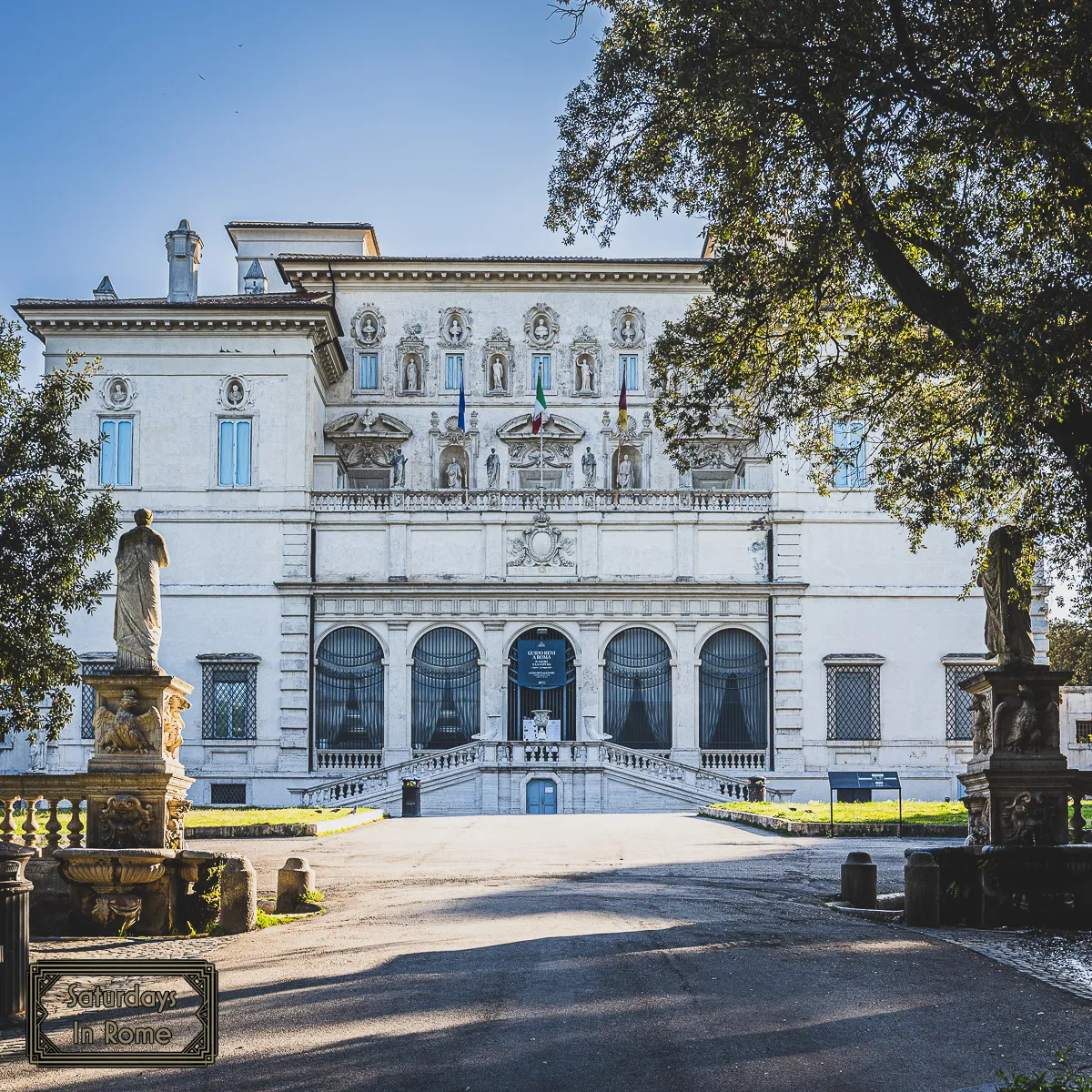
Galleria Borghese
Park History
The park of Villa Borghese Gardens is a vast area in the heart of the city and is the most popular park in Rome. The villa itself contains buildings, sculptures, monuments and fountains. It includes work of Baroque, Neoclassical and Eclectic artists and the grounds are surrounded by trees, ponds, gardens and large open spaces.
Camillo and Francesco Borghese expanded the park in the 19th century and in 1903 the Villa was purchased by the Italian state and has been used as a public park ever since. The most beautiful spot of Villa Borghese, for us, is the Garden of the lake where it is possible to rent boats and paddle around surrounded by the most tranquil setting in Rome.
Within the grounds of the park is also Galleria Borghese, which is in the villa and there is an art gallery originally integrated into the gardens, but today is considered a separate attraction with, of course, additional costs. For me, the Caravaggio collection is worth the price of admission but there are also works by Rubens, Titian, Raphael and the sculpture Apollo and Daphne by Bernini.
What Can I Do In The Borghese Gardens?
In addition to taking a casual stroll through the park and seeing the museum, which you should definitely check out, it is easy to spend an afternoon in the park.
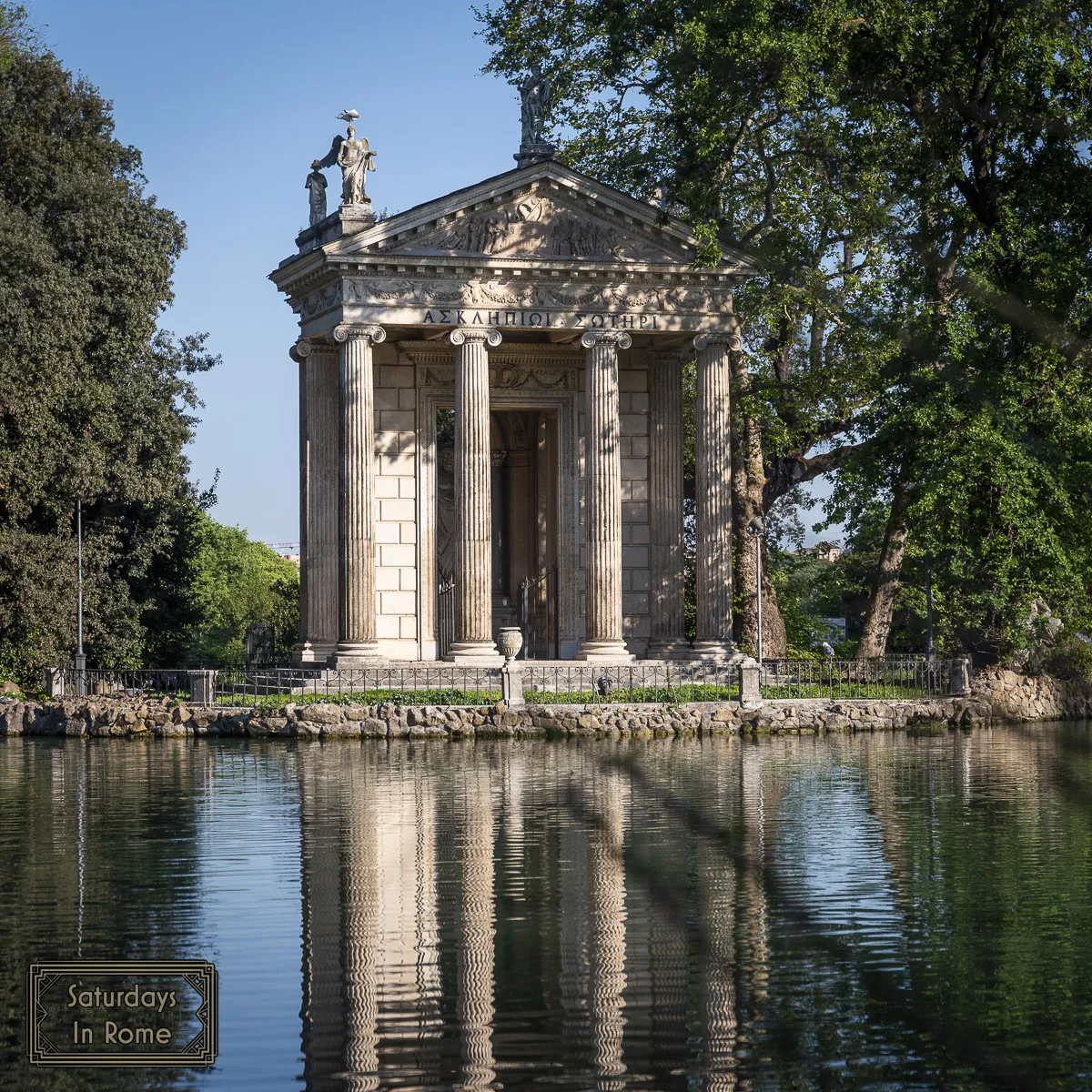
I mentioned above how you can rent a boat (read: tiny 2-person rowboat) which is inexpensive and has the fantastic view of the Temple of Aesculapius. You can also see a replica of Shakespeare’s Globe Theater, a Zoo, which was recently redesigned and a hydro-chronometer (water clock) built in 1873. If you get tired of walking, there are places to get a snack, a coffee or you can rent a bike or a cart.
What Are The Hours For The Borghese Gardens And The Galleria?
The park is open from dawn to dusk and like in any big city be sure to stay aware of your surroundings and don’t go to the more desolate parts when it is getting dark. As has been said before, Rome is generally a safe city with violent crime being very rare, but petty crime like pickpockets and purse snatching is not that uncommon, especially with tourists.
Large Map of Park
Now that COVID restrictions have loosened a bit, the Borghese Gallery is open until 10:00pm on Fridays and Saturdays. Tuesday through Sunday the museum opens at 9:00am and Tuesday through Thursday is closes at 7:00pm. I know this is a jumble, which is made worse by the inconsistent information on their website, so it wouldn’t hurt to call: +39 06 32810 (Monday through Friday 9:30am – 6:00pm).
The tours last 2 hours and there is a limit to 180 people at a time, so plan your day accordingly and make sure you make reservations.
Where Can I Get Tickets?
Reservations are required and you can make them at their reservation site, or you can call them: +39 06 32810 (Monday through Friday 9:30am – 6:00pm).
Where Is The Park?
The Villa Borghese Gardens are located on Pincian Hill which is close to Spanish Steps and Piazza del Popolo. There are a number of ways to get to the park, depending on where you are and what you want to see. The easiest way to reach the Gallery is walking through Villa Borghese Gardens, which is a great way to spend a morning.
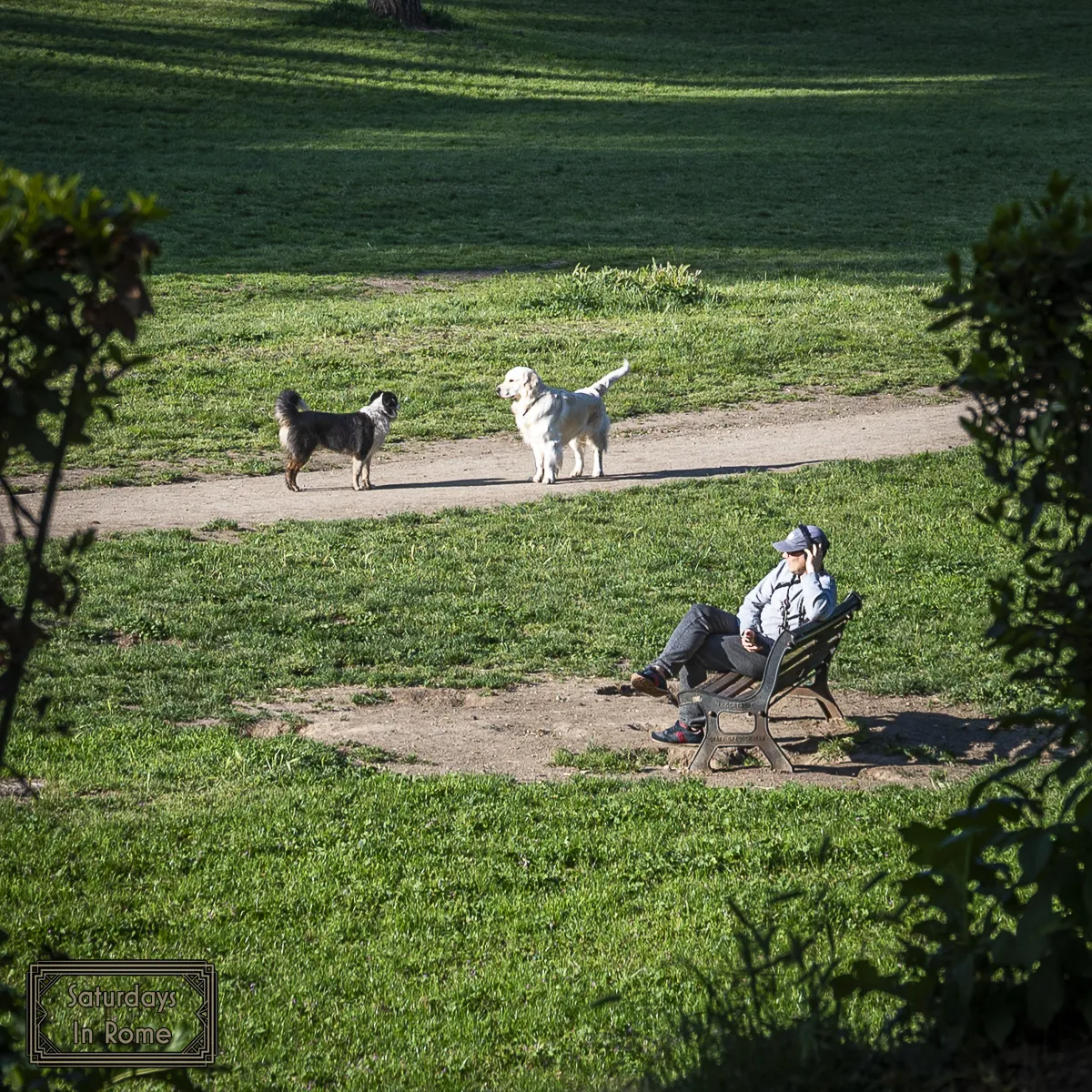
You can take the subway, Metro A, and get off at the Spagna or Flaminio stops, and climb the hill to reach Borghese Gallery. If you are at Piazza del Popolo, then climb the short flight of steps to the Pincio Hill garden. You might not know the name, but it is a popular spot that overlooks Piazza del Popolo. From there you can reach the museum with a 10 minutes walk.
You can also reach the park by the #2, #3 or #19 trams that stop at a number of stops around the park. Villa Borghese has 9 different entrances, so it’s better to check Google Maps to know where to go and how to get there.
Rome Travel Itinerary Planning
I hope that this Rome travel itinerary meets your needs on your first trip to Rome. If not, make adjustments as necessary and pace yourself so that you can enjoy some of the greatest gifts to all of humanity! If you are looking for ideas for your second or third trip to Rome, check out these itineraries:
- Planning A Trip To Rome Is Easy With Our Complete Guide
- We Can Help You Decide Where To Stay In Rome
- The Best Hotels Near The Vatican In Rome, Italy To Consider
- The Italian Hotel Star Rating System Is A Traveler’s Friend
- Hotels Near Piazza Navona Rome That Are A Great Option
- Great 5-Star Hotels Near Pantheon Rome To Check Out
- Amazing Rome Hotels Near Termini Station For Consideration
- Planning A Trip To Rome Alone That Is Safe And Exciting
- Planning A Trip To Rome On A Budget Can Be Done Easily
- Rome, Italy On A Budget Is Possible With These Tips
- 12 Useful Things To Know Before Traveling To Rome, Italy
- 3-Day Rome Itinerary Plans For Your Third Visit To Italy
- Your Second Time In Rome Still Needs An Itinerary
- A Complete Packing List For Men Who Are Coming To Rome
- A Fall And Spring Packing List For Men Coming To Rome
- A Winter Packing List For Men Who Are Coming To Rome
- A Summer Packing List For Men Who Are Coming To Rome

